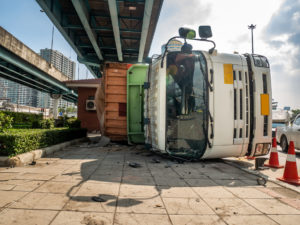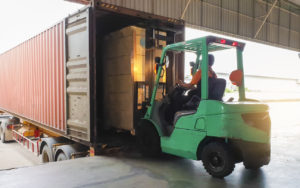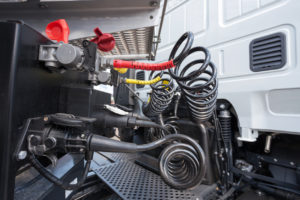Key Points:
- Mechanical Failures as a Cause of Accidents: Mechanical failures in 18-wheelers, such as tire blowouts and air brake failures, are significant contributors to semi-truck accidents. These malfunctions can lead to severe consequences, including catastrophic accidents that may endanger lives.
- Importance of Maintenance and Inspection: Regular maintenance and inspection procedures are crucial in preventing mechanical failures. Trucking companies, especially larger ones, have established routines for inspecting and maintaining their vehicles to avoid such failures, highlighting the role of preventive maintenance in enhancing road safety.
- Liability for Accidents Due to Mechanical Failures: When a mechanical failure directly leads to an accident, the truck’s owner may be held liable, provided it can be proven that negligence in maintenance and inspections contributed to the failure. However, liability can be complex and requires thorough investigation and concrete evidence to establish fault.
Do Mechanical Failures Cause Semi-Truck Accidents?
Every day, thousands of 18-wheelers navigate the highways throughout Atlanta’s metro area, sharing the roads with numerous other vehicles. It is crucial that every component of these trucks functions properly. A single malfunction in an 18-wheeler can lead to catastrophic consequences, potentially ending another person’s life. This assertion is not exaggerated, considering the severity of truck accidents. While some mechanical issues may not result in catastrophic outcomes, their impact varies. For instance, a tire blowout could cause the tire to detach and prompt other drivers to swerve unpredictably, whereas a failure in the air brakes could lead to a disastrous rear-end collision. In summary, mechanical failures in 18-wheelers are a significant cause of semi-truck accidents.
The Role of Malfunction Prevention
What Role Does Inadequate Maintenance Play in Semi-Truck Accidents?
This role is critical because it addresses the neglect that may lead to a truck accident caused by mechanical failure. While not all mechanical failures are preventable, a significant number can be avoided if trucking companies establish procedures for inspecting and maintaining their 18-wheelers, ensuring they are current and in good condition.
Do Trucking Companies Implement Maintenance Protocols to Prevent Semi-Truck Accidents Caused by Mechanical Failures?
There exists a wide variety of 18-wheelers operated by diverse entities, ranging from large corporations with their own trucking fleets to trucking companies and independent truckers who serve small to mid-sized businesses. Typically, larger companies have established procedures for regular truck inspections, aware that mechanical failures could result in significant financial losses. However, these systems are not foolproof, and mistakes can occur. On the other hand, smaller independent contractors might not have formal procedures, yet they often meticulously maintain their trucks, recognizing that their vehicle is crucial to their livelihood. Regardless of the operator’s size, thorough inspections and maintenance of trucks are essential for preventing accidents and saving lives.
What Measures Can a Company That Owns Semi-Trucks Take to Prevent Semi-Truck Accidents?
Trucking companies play a crucial role in ensuring the safety of their vehicles through a series of focused actions. These include conducting regular inspections, both through daily checks by drivers and periodic reviews by mechanics, focusing on key components like brakes and tires. Preventive maintenance, following manufacturers’ guidelines for services such as oil changes and brake replacements, helps avoid unexpected issues.
Adhering to strict legal standards for vehicle maintenance and keeping detailed records are also essential for compliance and safety. Training drivers to spot and report problems early, and utilizing technology for real-time vehicle monitoring, further enhances safety measures.
By consistently implementing these strategies, trucking companies can significantly reduce the risk of accidents caused by mechanical failures, contributing to safer roads for everyone.
Is the Trucking Company Responsible and at Fault for a Semi-Truck Accident Caused by Mechanical Failure?
In establishing fault, the objective is to pinpoint the negligence that led to the accident. If it is evident that a mechanical failure was the direct cause of the accident, then the truck’s owner holds liability. Mechanical failures do not leave room for excuses; if the truck owner had conducted proper inspections and maintenance, it’s possible that the failure could have been prevented.
However, in scenarios where a car initiates contact with the truck, causing a mechanical failure that leads to the accident, the car may be considered at fault. Yet, establishing liability in such cases requires concrete evidence. The determination of fault hinges on a thorough investigation and the presentation of clear proof.
Mechanical Malfunctions
Brake Failures
One of the most critical components for heavy vehicles, brake failures in semi trucks can result from overheating, wear and tear, or inadequate maintenance. Such failures can lead to the inability to stop or slow down, causing rear-end collisions or runaway truck scenarios.
- Why/How Accidents Happen: Brake failures can result from worn-out brake pads, overheating, or leaks in the brake system. They lead to the driver’s inability to stop the truck in time, potentially causing rear-end collisions or loss of control.
- Prevention: Regular inspections and maintenance of the brake system, including replacing worn parts and checking for leaks, can prevent brake failures.
How to Prove Brake Failure Was the Cause of the Truck Accident
If the accident involved brake failure, it’s likely a rear-end collision, which typically simplifies the process of proving liability. Your truck accident attorney can arrange for a mechanic to inspect the truck’s brakes, determining their remaining lifespan—or lack thereof—if they weren’t replaced. Should it be found that the brakes were recently replaced, this could strongly indicate that the previous brakes were faulty or excessively worn, supporting the case for liability.
Tire Blowouts
Tires on semi trucks endure considerable stress due to heavy loads and long distances. Blowouts can occur due to poor maintenance, overloading, or defects. A sudden blowout can cause the driver to lose control, leading to jackknifing or veering off the road.
- Why/How Accidents Happen: Tire blowouts can occur due to overloading, under-inflation, or wear and tear. A sudden blowout can cause the driver to lose control, especially at high speeds, leading to swerving or overturning.
- Prevention: Routine tire inspections for wear and damage, maintaining proper tire pressure, and adhering to weight limits can prevent blowouts.
How to Prove a Tire Blowout Was the Cause of a Truck Accident
To prove a tire blowout caused a truck accident, collect evidence like tire pieces and skid marks, review maintenance records for neglect, and consult a vehicle expert to analyze the tire’s condition before the accident. This evidence can show that the blowout was preventable and directly led to the accident.
Steering System Failures
The steering mechanism is vital for maneuvering the vehicle. Failures in this system can result from hydraulic fluid leaks, worn components, or mechanical defects, leading to loss of control.
- Why/How Accidents Happen: Failures in the steering system can occur due to worn or faulty steering components, making it difficult or impossible for the driver to steer the truck. This can lead to the driver losing control of the vehicle.
- Prevention: Regular inspections and maintenance of the steering components, including fluids and linkages, ensure proper steering functionality.
How to Prove a Steering System Failure Caused a Truck Accident
To prove steering system failure caused a truck accident, gather the truck’s maintenance records, have an expert inspect the steering components for faults, and use accident reconstruction to show how the failure led to the accident. This evidence collectively demonstrates that the steering system’s malfunction was the accident’s direct cause.
Transmission Failures
The transmission system is crucial for changing gears and maintaining speed. Failures here can lead to sudden loss of power or unexpected shifting, disrupting the driver’s control over the vehicle.
- Why/How Accidents Happen: Transmission failures can make it impossible to change speeds or use certain gears, leading to loss of control or the inability to move the vehicle out of harm’s way.
- Prevention: Routine maintenance of the transmission system, including fluid checks and component inspections, can help detect and prevent failures.
How to Prove a Transmission Failure Caused a Truck Accident
To prove transmission failure caused a truck accident, collect the truck’s service history, get an expert to inspect the transmission for faults, and use accident reconstruction to connect the failure to the accident. This strategy uses evidence, expert insight, and technical analysis to show the failure’s direct impact.
Engine Overheating
Overheating can lead to engine failure, often due to coolant leaks, blocked radiators, or malfunctioning thermostats. An overheated engine can stall the truck unexpectedly, causing hazards, especially on high-speed roadways.
- Why/How Accidents Happen: Engine overheating can lead to engine failure or fires. Overheating may be caused by low coolant levels, radiator issues, or prolonged use under heavy loads.
- Prevention: Regular checks and maintenance of the cooling system, along with monitoring engine temperatures and avoiding overloading, can prevent overheating.
How to Prove a Engine Overheating Caused a Truck Accident
To prove engine overheating led to a truck accident, gather the truck’s maintenance history, have an expert assess the engine for overheating evidence, and employ accident reconstruction to show how the overheating caused the accident. This method uses records, expert analysis, and technical proof to link overheating to the crash.
Electrical System Failures
Modern trucks rely heavily on electrical systems for navigation, lighting, and internal mechanics. Electrical faults can lead to loss of lighting, instrument panel outages, or even fires.
- Why/How Accidents Happen: Electrical failures can affect lighting, braking systems, and other critical controls. Issues such as short circuits or dead batteries can lead to malfunctions or loss of vehicle control.
- Prevention: Regular inspections of the electrical system, including batteries, wiring, and connections, can identify and fix potential issues before they lead to failures.
How to Prove that an Electrical System Failure Caused a Truck Accident
To prove an electrical system failure caused a truck accident, gather the truck’s repair history, get an electrical expert to inspect for malfunctions, and use accident reconstruction to link the failure to the accident. This method uses documentation, expert findings, and analysis to demonstrate the failure’s role in the crash.
Trailer Attachment Failures
The connection between the truck and its trailer is crucial for stability. Failures in the hitching mechanism can lead to the trailer detaching and becoming an uncontrolled hazard on the road.
- Why/How Accidents Happen: If the trailer is not properly attached, it can detach from the truck, leading to accidents involving other vehicles or pedestrians. Improper attachment can result from faulty locking mechanisms or wear and tear.
- Prevention: Ensuring proper training for drivers on attaching trailers and regular inspections of attachment mechanisms can prevent detachment incidents.
How to Prove that a Trailer Attachment Failure Caused a Truck Accident
To prove a trailer attachment failure caused a truck accident, collect the truck’s maintenance history, get an expert to check the attachment for faults, and use accident reconstruction to show how the failure led to the accident. This method combines records, expert analysis, and technical proof to demonstrate the failure’s impact on the crash.
Load Securing Issues
Improperly secured or overloading can affect the truck’s stability and handling. Shifts in load during transit can cause imbalances, leading to rollovers or loss of control.
- Why/How Accidents Happen: Improperly secured loads can shift during transport, causing imbalance or falling debris. This can lead to the truck overturning or creating road hazards for other vehicles.
- Prevention: Proper training on load securing techniques, regular inspections of load before and during trips, and adherence to weight distribution guidelines can prevent accidents related to load issues.
How to Prove that a Load Securing Issue Caused a Truck Accident
To prove a load securing issue caused a truck accident, review the truck’s loading records for safety adherence, have a cargo securing expert inspect for securing failures, and use accident reconstruction to link the issue to the accident. This method uses records, expert insight, and analysis to show how the securing problem led to the crash.
Regulations set by the Federal Motor Carrier Safety Administration (FMCSA) mandate strict maintenance and inspection protocols for semi-trucks to prevent mechanical failures and ensure road safety. These include compulsory routine inspections—pre-trip, en-route, and post-trip by the driver, and at least annual checks by qualified professionals. Trucking companies must maintain detailed records of all maintenance and repairs, which include dates, inspector details, findings, and repair descriptions. A systematic preventive maintenance program is also required, based on either the manufacturer’s recommendations or industry best practices, covering essential components like brakes, tires, and lights.
Drivers are trained to conduct thorough pre-trip inspections and to recognize signs of potential mechanical issues, alongside knowing how to report these problems. Adherence to the vehicle manufacturer’s maintenance recommendations is crucial, with specific attention to the brake system and cargo securement standards to prevent accidents. Non-compliance with FMCSA regulations can lead to significant penalties, including fines and operational bans, highlighting the importance of these measures in promoting the safety and reliability of semi-truck operations.
Cargo load issues, when combined with mechanical failures, significantly contribute to semi-truck accidents. Overloaded or improperly secured cargo can lead to increased stress on the truck’s mechanical systems, such as brakes and tires, leading to premature wear or failure. For example, an overloaded truck requires longer distances to stop, putting excessive strain on the brake system. Similarly, unevenly distributed loads can cause imbalanced tire wear, increasing the risk of blowouts. These mechanical issues not only compromise the truck’s handling and stability but also elevate the risk of catastrophic accidents on the road, underscoring the critical need for strict adherence to cargo loading regulations and regular vehicle maintenance.
The age of a semi-truck significantly affects its risk of mechanical failures that could lead to accidents. Older trucks experience more wear and tear, affecting crucial parts like brakes and engines, and they may lack the advanced safety technologies found in newer models. While regular maintenance is crucial for older trucks to mitigate these risks, the likelihood of unexpected mechanical issues still increases with age, making these trucks more prone to accidents caused by mechanical failures.
Yes, a truck driver can potentially sue their company if a truck failure that caused an accident resulted in their injury, under certain circumstances. If it can be demonstrated that the company failed to adhere to maintenance protocols, ignored safety regulations, or was otherwise negligent in ensuring the truck’s safe operation, the driver might have grounds for a lawsuit. The key to such a legal claim is proving that the company’s negligence directly contributed to the accident and the driver’s injuries. Laws and regulations governing these situations can vary by jurisdiction, so it’s advisable for the driver to consult with a legal professional who specializes in labor and personal injury law to explore their options and understand their rights.
Yes, weather can cause mechanical failures on a big rig semi-truck. Extreme temperatures, whether hot or cold, can stress a truck’s mechanical systems. In cold weather, for example, the risk of battery failure increases, fluids can thicken, leading to transmission and engine issues, and ice can affect the braking system’s effectiveness. Hot weather can lead to engine overheating, tire blowouts due to increased air pressure, and the degradation of hoses and belts. Additionally, wet or icy conditions can exacerbate wear on brakes and tires. Regular maintenance and weather-specific precautions can mitigate these risks, but the impact of severe weather on a truck’s mechanical systems can significantly increase the likelihood of failures that could lead to accidents.

 1201 West Peachtree Street #2339 Atlanta, GA 30309+1-770-212-3795$0-$100000
1201 West Peachtree Street #2339 Atlanta, GA 30309+1-770-212-3795$0-$100000Millar Law Firm is an exceptional Personal Injury firm. The attorneys are knowledgeable, dedicated, and honest. I greatly appreciate the positive impact that they continue to make on the Atlanta community. Thank you!
















